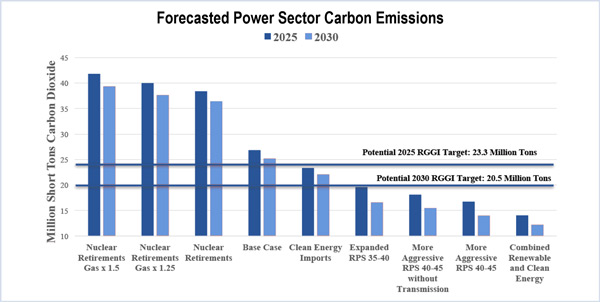By Michael Kuser
New England states will not have enough renewable resources to meet the 2025 and 2030 targets in current renewable portfolio standards without adding transmission for new onshore wind, according to a scenario analysis conducted for the New England States Committee on Electricity.
NESCOE’s Renewable and Clean Energy Mechanisms 2.0 Study used a model from London Economics to evaluate the impact of five scenarios on prices, emissions and “missing money” — the potential gap between generators’ revenues and their operating costs.
ISO-NE officials provided a briefing on the Phase I findings — part of the New England Power Pool’s Integrating Markets and Public Policy (IMAPP) initiative — at the NEPOOL Participants Committee meeting on April 7.
The results are expected to be discussed at FERC’s technical conference May 1-2 on tensions between state public policies and wholesale markets in ISO-NE, PJM and NYISO.
The study builds on NESCOE’s December 2015 whitepaper, “Mechanisms to Support Public Policy Resources in the New England States.”
One scenario that considered the accelerated retirement of the region’s nuclear capacity included sensitivities based on natural gas prices. One that looked at more renewables and transmission considered several alternatives for expanded state renewable standards.
The study concluded that new renewable generation or additional clean energy imports to New England with very low marginal costs will cut energy and capacity revenues for all other resources. Nevertheless, the study noted that under every scenario considered, nuclear generators, existing oil combustion turbines, oil internal combustion turbines, oil steam and pumped storage will remain profitable in 2025 and 2030.
The study found that under base case load conditions, New England’s addition of more than 25 million MWh annually of renewable resources and/or clean energy imports by 2025 would cause existing renewable and clean energy resources to produce less power.
If the region doesn’t build new transmission to move power from new onshore wind to load centers, both new and existing onshore wind “will operate less often and earn less revenue in 2025 and 2030,” the study said.
Unsurprisingly, it also concludes that the retirement of the region’s nuclear generation would “significantly” increase carbon emissions, as would a failure to increase renewable capacity above current RPS levels.
Phase II of the study will test the operability of each scenario and assess additional market outcomes:
- Natural gas pipeline constraints, to be discussed with the Planning Advisory Committee in the second quarter;
- Forward Capacity Auction prices, also to be discussed with the PAC in Q2; and
- Frequency regulation, ramping and reserves, to be discussed with the PAC in the fourth quarter.
FERC last week released the agenda for the May 1-2 technical conference (AD17-11).
Before the conference, ISO-NE plans to issue a summary of its “concept for accommodating additional state-subsidized resources and their associated pricing impacts on the capacity market.” The New England Conference of Public Utilities Commissioners Symposium in Connecticut in May and the NEPOOL Participants Committee summer meetings may allow for additional dialogue on the concept, said Chief Operating Officer Vamsi Chadalavada.
ISO-NE likely will file any related proposals with FERC by the end of 2017 to allow for implementation ahead of FCA 13.
The grid operator also is evaluating fuel security issues and their effect on the bulk power grid and plans to discuss its findings with stakeholders during the second half of 2017.
ISO-NE Considers Accelerating Ramping Pricing Effort
Chadalavada also updated the Participants Committee on the Updated 2017 Work Plan, saying the RTO is considering accelerating its discussions of potential pricing approaches for resource ramping.
Previously, the grid operator had delayed the resource ramping assessment to follow both IMAPP and the day-ahead reserve market enhancement assessment. The RTO now plans to hold technical sessions on how ramping currently works and to survey how other regions are handling the issue by the fourth quarter of this year.
The COO also said ISO-NE’s 2017 long-term load, energy-efficiency and solar PV forecasts are nearly complete. “The overall trend is lower net energy and seasonal peak demand for New England,” Chadalavada said.
NEPOOL Seeks Flexibility on DA Market Schedule
The NEPOOL Participants Committee unanimously supported a Tariff revision recommended by the Transmission Committee providing more flexibility in the day-ahead market schedule.
The change eliminates the requirement that real-time external transactions at interfaces not subject to coordinated transaction scheduling be submitted into the real-time energy market before “noon the day before the Operating Day.” The new text says the deadline will be specified in Section III.1.10.1A of the Tariff.




